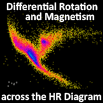Speaker
Dieter Schmitt
(Max-Planck-Institut für Sonnensystemforschung, Lindau)
Description
The velocity and magnetic fields are well-known on the solar surface. Surface flux
transport models describe the evolution of the magnetic field after emergence on the
surface under the action of differential rotation, meridional circulation and
turbulent magnetic diffusivity. Especially the polar field and the Sun's open flux
are determined by the surface distribution of the magnetic field. Here the tilt
angles of emerging bipolar regions,
inflows into active regions and cross-equatorial flux transport and diffusion play
important roles. The average tilt angles of sunspot groups vary from cycle to cycle,
roughly anticorrelated with the cycle amplitudes. Furthermore is the Sun's open flux
at minimum strongly correlated with the level of activity of the subsequent cycle.
Besides the emergence and evolution of the surface magnetic field, the transport of
poloidal flux to the tachocline, the generation of toroidal magnetic flux due to
differential rotation, and the
subsequent formation and rise of flux tubes through the convection zone until they
emerge at the surface
are building blocks of the solar dynamo. In this talk we discuss how the solar
dynamo could be constraint by the empirical findings at the surface.
Authors
Dieter Schmitt
(Max-Planck-Institut für Sonnensystemforschung, Lindau)
Emre Işık
(Department of Physics, Faculty of Science & Letters, Istanbul Kültür University)
Jie Jiang
(Key Lab. of Solar Activity, National Astronom. Obs, Chinese Academy of Sciences, Beijing)
Manfred Schüssler
(Max-Planck-Institut für Sonnensystemforschung, Lindau)
Robert Cameron
(Max-Planck-Institut für Sonnensystemforschung, Lindau)

